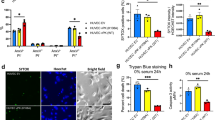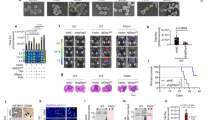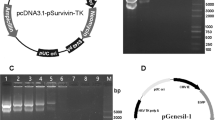Abstract
During herpes simplex virus type 1 (HSV 1) infection, the tegument protein VP22 is exported from infected cells to the nuclei of surrounding uninfected cells. These intercellular transport characteristics have prompted the exploitation of VP22 fusion proteins for cancer gene therapy, with the goal of maximizing the bystander effect. Since solid tumors contain hypoxic cell populations that are often refractive to therapy, for efficient targeting, it would be optimal if VP22 functioned even at reduced oxygen concentrations. In the present work, VP22 activity under hypoxic conditions was examined for the first time. Plasmid-transfected human glioma U87-MG and U373-MG cells expressing VP22 fused to the green fluorescent protein (GFP) showed protein export to untransfected cells under tumor oxygenation conditions (0–5% O2). For suicide gene therapy, VP22 activity was demonstrated under hypoxia by coupling VP22 to the HSV thymidine kinase (HSVtk). In the presence of the prodrug ganciclovir, cell cultures expressing VP22-HSVtk showed a significant increase in toxicity compared with cells transfected with a construct containing HSVtk only, under all tested conditions. To allow effective suicide gene therapy and simultaneous visualization of therapeutic enzyme localization, a triple fusion protein GFP-HSVtk-VP22 was engineered. Functionality of all components was demonstrated under oxia and hypoxia.
This is a preview of subscription content, access via your institution
Access options
Subscribe to this journal
Receive 12 print issues and online access
$259.00 per year
only $21.58 per issue
Buy this article
- Purchase on Springer Link
- Instant access to full article PDF
Prices may be subject to local taxes which are calculated during checkout






Similar content being viewed by others
References
Elliott G, O'Hare P . Intercellular trafficking and protein delivery by a herpesvirus structural protein. Cell 1997; 88: 223–233.
Elliott G, O'Hare P . Intercellular trafficking of VP22-GFP fusion proteins. Gene Therapy 1999; 6: 149–151.
Wybranietz WA et al. Quantification of VP22-GFP spread by direct fluorescence in 15 commonly used cell lines. J Gene Med 1999; 1: 265–274.
Dilber MS et al. Intercellular delivery of thymidine kinase prodrug activating enzyme by the herpes simplex virus protein, VP22. Gene Therapy 1999; 6: 12–21.
Wybranietz WA et al. Enhanced suicide gene effect by adenoviral transduction of a VP22- cytosine deaminase (CD) fusion gene. Gene Therapy 2001; 8: 1654–1664.
Phelan A, Elliott G, O'Hare P . Intercellular delivery of functional p53 by the herpesvirus protein VP22. Nat Biotechnol 1998; 16: 440–443.
Wills KN et al. Intratumoral spread and increased efficacy of a p53-VP22 fusion protein expressed by a recombinant adenovirus. J Virol 2001; 75: 8733–8741.
Fyles AW et al. Oxygenation predicts radiation response and survival in patients with cervix cancer. Radiother Oncol 1998; 48: 149–156.
Brizel DM, Dodge RK, Clough RW, Dewhirst MW . Oxygenation of head and neck cancer: changes during radiotherapy and impact on treatment outcome. Radiother Oncol 1999; 53: 113–117.
Hockel M, Schlenger K, Hockel S, Vaupel P . Hypoxic cervical cancers with low apoptotic index are highly aggressive. Cancer Res 1999; 59: 4525–4528.
Greco O, Marples B, Joiner MC, Scott SD . How to overcome (and exploit) tumor hypoxia for targeted gene therapy. J Cell Physiol 2003; 197: 312–325.
Bouvet M et al. Real-time optical imaging of primary tumor growth and multiple metastatic events in a pancreatic cancer orthotopic model. Cancer Res 2002; 62: 1534–1540.
Li CY et al. Initial stages of tumor cell-induced angiogenesis: evaluation via skin window chambers in rodent models. J Natl Cancer Inst 2000; 92: 143–147.
Zhang W et al. Direct gap junction communication between malignant glioma cells and astrocytes. Cancer Res 1999; 59: 1994–2003.
Cotrina ML et al. Connexins regulate calcium signaling by controlling ATP release. Proc Natl Acad Sci USA 1998; 95: 15735–15740.
Greco O, Scott SD, Marples B, Dachs GU . Cancer gene therapy: ‘delivery, delivery, delivery’. Front Biosci 2002; 7: d1516–d1524.
Lundberg M, Johansson M . Is VP22 nuclear homing an artifact? Nat Biotechnol 2001; 19: 713–714.
Fang B, Xu B, Koch P, Roth JA . Intercellular trafficking of VP22-GFP fusion proteins is not observed in cultured mammalian cells. Gene Therapy 1998; 5: 1420–1424.
Cashman SM et al. Intercellular trafficking of adenovirus-delivered HSV VP22 from the retinal pigment epithelium to the photoreceptors – implications for gene therapy. Mol Ther 2002; 6: 813–823.
Zavaglia D et al. Intercellular trafficking and enhanced in vivo antitumour activity of a non-virally delivered P27-VP22 fusion protein. Gene Therapy 2003; 10: 314–325.
Tupper J, Greco O, Tozer GM, Dachs GU . Analysis of the horseradish peroxidase/indole-3-acetic acid combination in a three-dimensional tumor model. Cancer Gene Ther 2004; 11: 508–513.
Griffiths L et al. The macrophage – a novel system to deliver gene therapy to pathological hypoxia. Gene Therapy 2000; 7: 255–262.
Black ME, Newcomb TG, Wilson HM, Loeb LA . Creation of drug-specific herpes simplex virus type 1 thymidine kinase mutants for gene therapy. Proc Natl Acad Sci USA 1996; 93: 3525–3529.
Kokoris MS, Sabo P, Adman ET, Black ME . Enhancement of tumor ablation by a selected HSV-1 thymidine kinase mutant. Gene Therapy 1999; 6: 1415–1426.
Zender L et al. Gene therapy by intrahepatic and intratumoral trafficking of p53-VP22 induces regression of liver tumors. Gastroenterology 2002; 123: 608–618.
Aints A et al. Mapping of herpes simplex virus-1 VP22 functional domains for inter- and subcellular protein targeting. Gene Therapy 2001; 8: 1051–1056.
Leslie J, Rixon FJ, McLauchlan J . Overexpression of the herpes simplex virus type 1 tegument protein VP22 increases its incorporation into virus particles. Virology 1996; 220: 60–68.
Scott SD et al. A radiation-controlled molecular switch for use in gene therapy of cancer. Gene Therapy 2000; 7: 1121–1125.
Marples B et al. Development of synthetic promoters for radiation-mediated gene therapy. Gene Therapy 2000; 7: 511–517.
Acknowledgements
We are grateful to Dr George Wilson for useful discussion, Dr Margaret Black for the HSVtkm clone, Dr John McLauchlan for the VP22 clone and Dr Peter O'Hare for the anti-VP22 sera. This work is supported by The Susan G Komen Breast Cancer Foundation, Wayne State University, Academic Radiation Oncologists and Radiation Oncology Research & Development Center, Detroit, MI, USA.
Author information
Authors and Affiliations
Rights and permissions
About this article
Cite this article
Greco, O., Joiner, M., Doleh, A. et al. VP22-mediated intercellular transport for suicide gene therapy under oxic and hypoxic conditions. Gene Ther 12, 974–979 (2005). https://doi.org/10.1038/sj.gt.3302482
Received:
Revised:
Published:
Issue Date:
DOI: https://doi.org/10.1038/sj.gt.3302482
Keywords
This article is cited by
-
Evidence for Intercellular Trafficking of VP22 in Living Cells
Molecular Therapy (2007)



